As an Amazon Associate KitchenwareSets.com earns from qualifying purchases.
11 Genius Small Japanese Kitchen Design Ideas to Maximize Space
Feeling boxed in by your own kitchen? If you’re constantly battling for counter space, struggling with overflowing cabinets, and feeling like your cooking area is more chaotic than creative, you are not alone. A small kitchen can often feel like a puzzle with no solution, leading to frustration and a space you want to escape from rather than enjoy. The clutter isn’t just physical; it creates mental noise, making one of the most important rooms in your home feel stressful and inefficient. After helping countless readers transform their compact living areas, we’ve learned that the most impactful changes often come from the smartest, not the largest, design philosophies. This guide distills those learnings for your kitchen.
The solution isn’t about knocking down walls or undertaking a massive, expensive renovation. It’s about a shift in perspective, inspired by a design philosophy perfected over centuries. A small Japanese kitchen maximizes space by focusing on minimalism, multi-functionality, and natural materials. This approach isn’t just about aesthetics; it’s a practical strategy to eliminate clutter and use smart storage, creating a kitchen that feels open, serene, and incredibly efficient, even within a tiny footprint. Get ready to discover 11 genius ideas that will transform your cramped kitchen into a peaceful and functional haven.
11 Genius Small Japanese Kitchen Design Ideas to Maximize Your Space (2025 Update)
Ready to turn your small kitchen from cluttered to calm? This curated collection of 11 genius ideas blends the timeless principles of Japanese design with modern space-saving strategies. Each tip is practical, actionable, and perfect for renters and homeowners alike. We’ve focused on proven techniques that create a kitchen that is not only beautiful and serene but also a true joy to cook in. Each idea is selected based on core Japanese design principles and proven space-maximizing strategies for compact urban living.
1. Embrace Verticality with Minimalist Floating Shelves
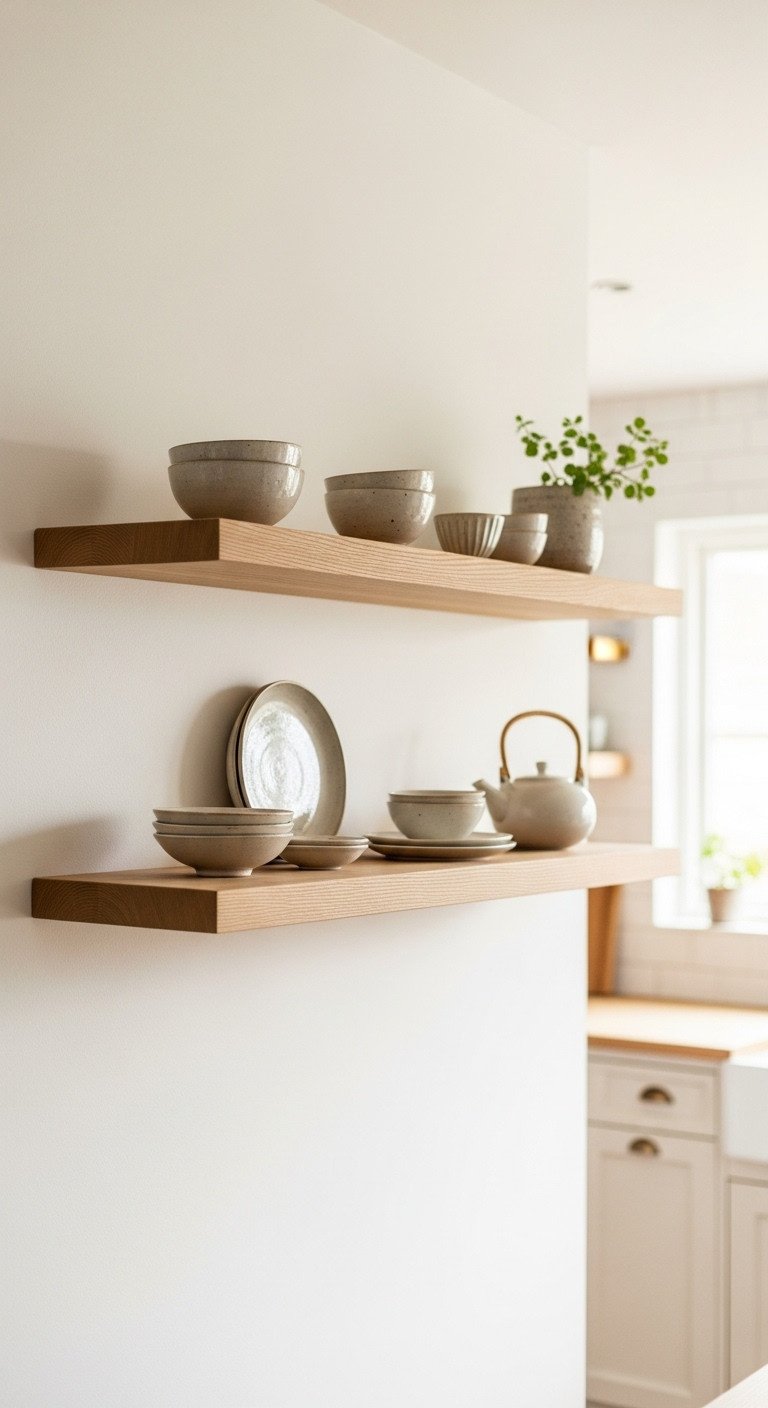
The most effective way to add storage without adding bulk is to go vertical with light wood floating shelves. This draws the eye upward, creating an illusion of height and openness while keeping your most beautiful and frequently used items within easy reach.
- Materials Needed: Light wood floating shelves (e.g., oak, bamboo), heavy-duty hidden shelf brackets, level, drill, wall anchors appropriate for your wall type.
- Step-by-Step Directions:
- Identify the wall space you want to utilize. Choose a spot that is accessible but doesn’t obstruct movement.
- Measure and mark the placement for your brackets, using a level to ensure they are perfectly straight.
- Install the brackets securely to the wall. It is critical to use heavy-duty floating shelf brackets that can support the weight of your dishes and cookware.
- Slide the shelves onto the brackets.
- Style the shelves minimally. Arrange your most beautiful ceramics, tea sets, or glasses, leaving ample empty space around each item to maintain a clean, uncluttered look.
Pro-Tip: Always install shelves into wall studs for maximum support. If studs aren’t available, use high-quality toggle bolt wall anchors rated for well above the weight you plan to store.
Pin this minimalist shelf idea for your dream kitchen!
2. Ground the Space with Natural Wood Elements
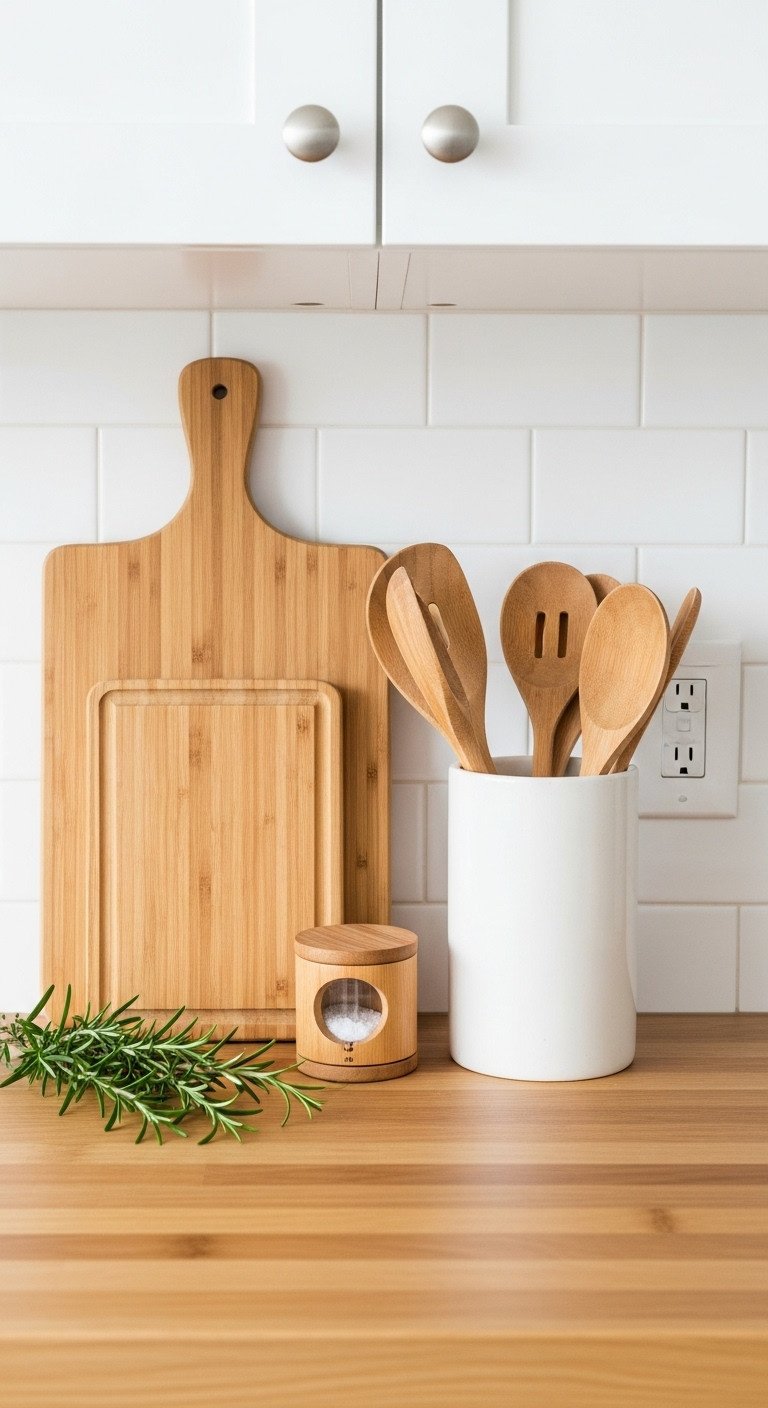
To prevent a minimalist kitchen from feeling cold, incorporate natural wood elements to add warmth and organic texture. Materials like oak, bamboo, and hinoki connect the space to nature, a core tenet of Japanese design, making it feel grounded and inviting.
- Materials Needed: Wood-based accessories like cutting boards, utensil holders, knife blocks, or serving bowls.
- Step-by-Step Directions:
- Start small if you’re not ready for a big change. Introduce bamboo or acacia wood accessories.
- A high-quality Japanese hinoki wood cutting board is a perfect starting point. It’s beautiful, functional, and naturally antibacterial.
- Replace plastic utensil holders with a simple wooden or bamboo version.
- If planning a remodel, consider light wood cabinets or a butcher block countertop to make wood the foundational element of your design.
- Coordinate wood tones. Stick to either all warm-toned woods (like oak) or all cool-toned woods (like ash) for a cohesive look.
Lesson Learned: Don’t mix too many different wood stains in a small space. It can look busy. Sticking to 1-2 complementary tones creates a more serene and intentional design.
Save this warm wood inspiration to your “Japandi Kitchen” board!
3. Create Calm with a Muted, Earthy Color Palette
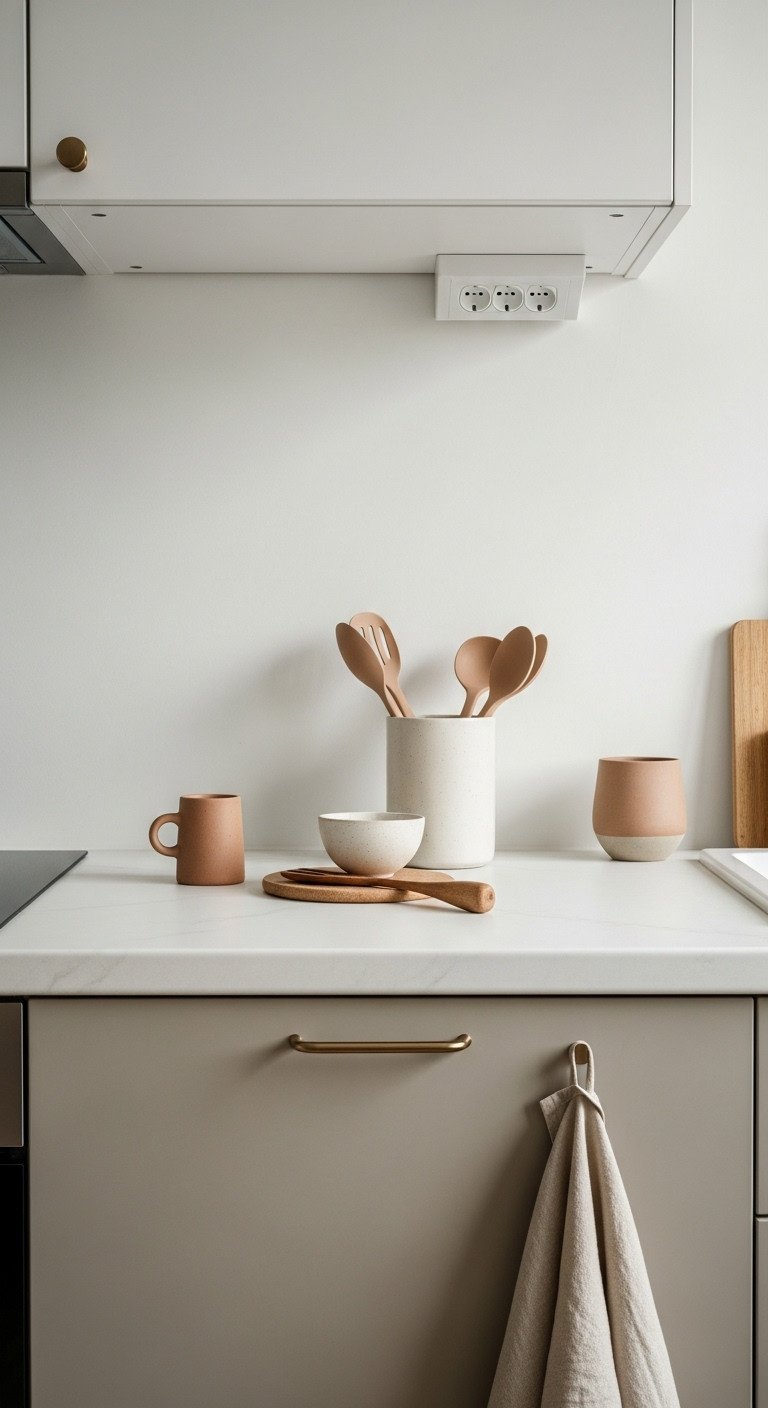
The secret to a serene kitchen is a calm, muted color palette based on earthy tones. Colors like beige, sand, cream, and soft grey reflect light, making the space feel larger and creating a tranquil atmosphere that promotes mindfulness while you cook.
- Materials Needed: Paint in neutral shades (beige, cream, soft grey), painting supplies, neutral-toned kitchen accessories.
- Step-by-Step Directions:
- Choose a primary neutral color for your walls or cabinets, such as a warm white or a soft beige. These colors reflect light and make the space feel larger.
- Select one or two complementary earthy tones for accents. This could be through your backsplash tile, textiles, or decorative objects.
- Incorporate texture to keep the neutral palette interesting. Think of a linen tea towel, a stoneware vase, or a ceramic kitchen utensil holder in a sand or beige color.
- Use a dark color, like black or charcoal, very sparingly for contrast. This could be on cabinet hardware, a faucet, or a single light fixture.
Pro-Tip: Always get paint samples and test them on your walls. The color will look different depending on the natural and artificial light in your specific kitchen.
Love these calm colors? Pin it for your next paint project!
4. Layer Your Lighting for Warmth and Function
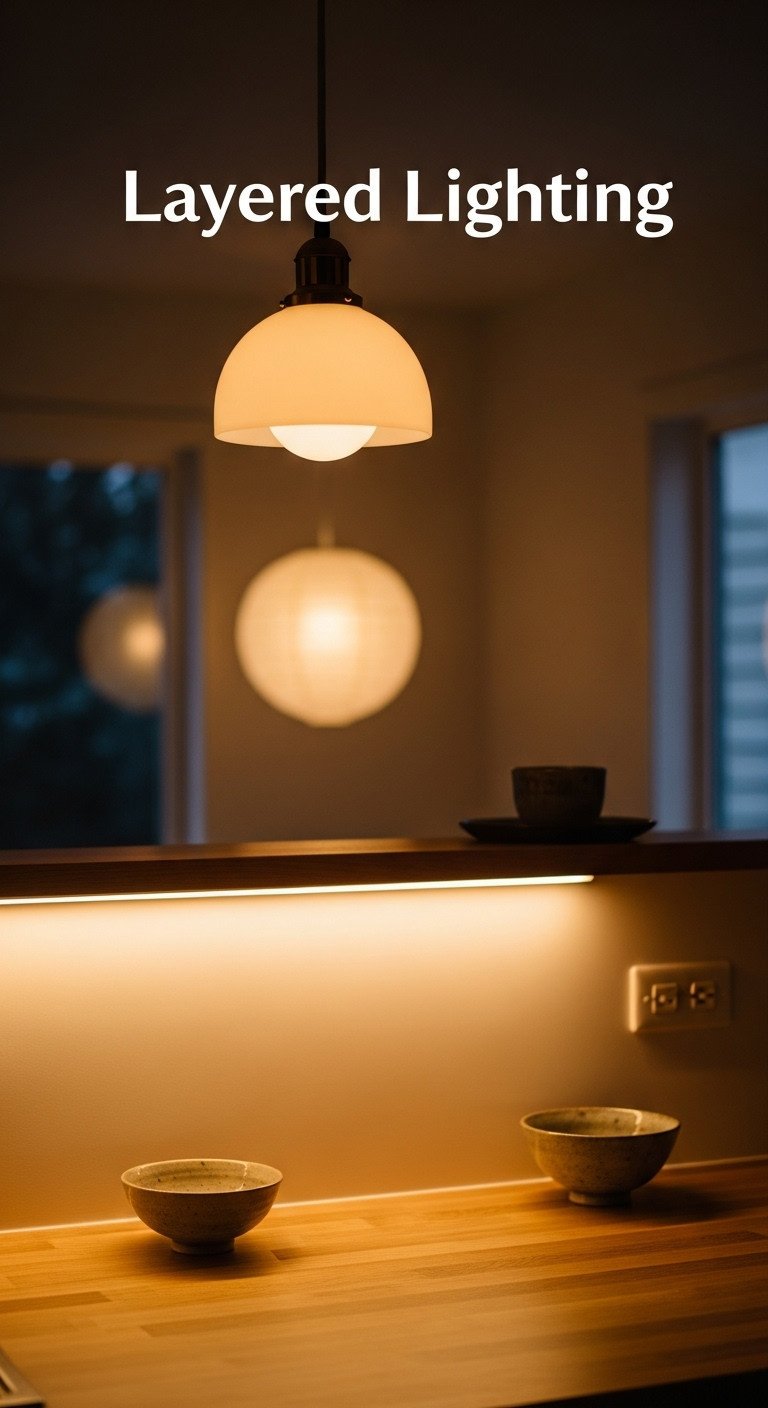
Good lighting is transformative, and the key is to use multiple layers of light for both function and ambiance. Combining ambient, task, and accent lighting eliminates shadows, makes the kitchen safer to work in, and creates a warm, inviting atmosphere.
- Materials Needed: Under-cabinet LED light strips, ceiling fixture, dimmer switches.
- Step-by-Step Directions:
- Task Lighting: This is the most important layer for cooking. Install an LED under-cabinet lighting kit to illuminate your countertops. Choose a warm white temperature (around 2700K-3000K) for an inviting glow.
- Ambient Lighting: For overall illumination, use a simple, flush-mount ceiling light or minimalist track lighting.
- Accent Lighting: If you have an island or a small dining nook, hang a single statement pendant light. A fixture with a natural material like wood or rice paper works perfectly.
- Install dimmer switches wherever possible to control the mood, from bright and functional to soft and relaxing.
Lesson Learned: A common mistake is using only one harsh overhead light. Layering task and ambient lighting is the single biggest factor in making a kitchen feel warm and high-end.
Brighten your kitchen! Save this lighting idea!
5. Achieve a Seamless Look with Handleless Cabinetry
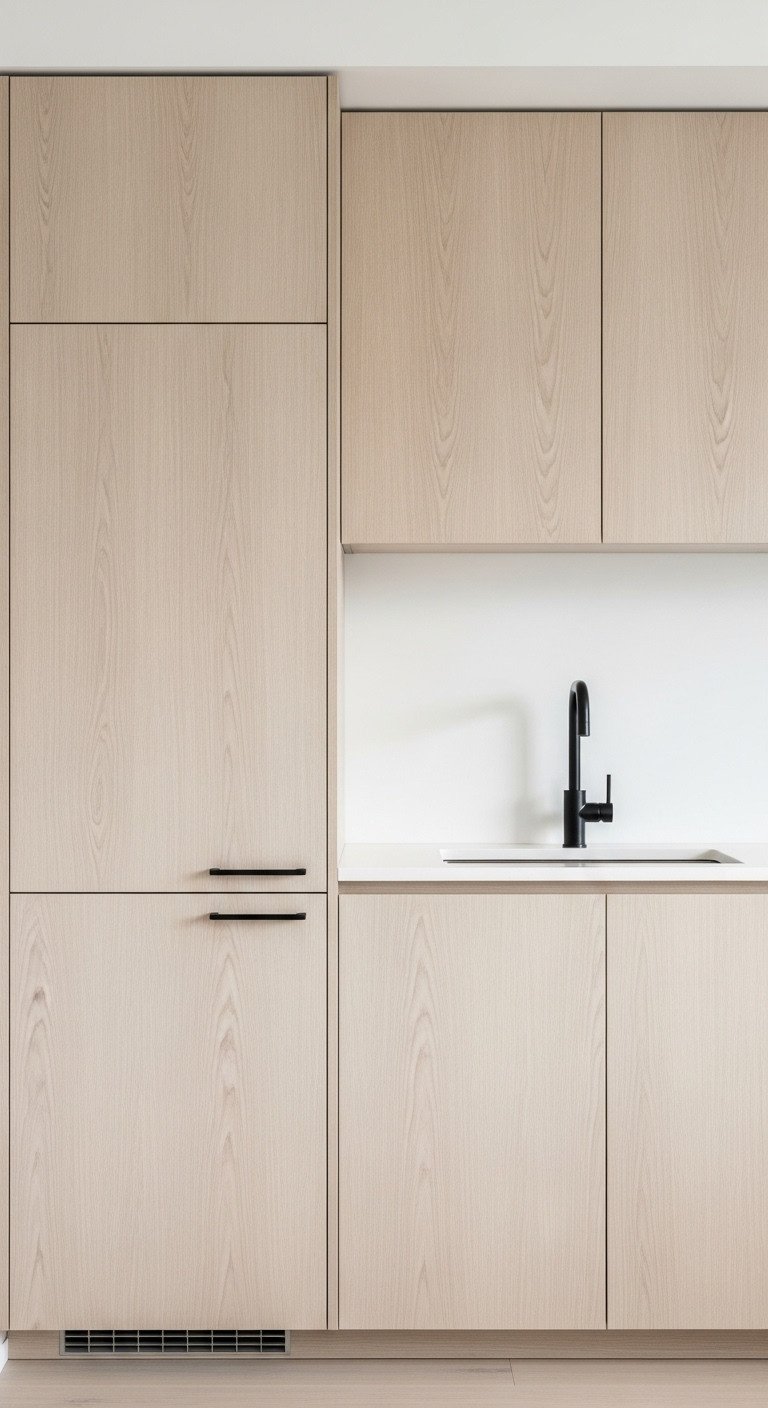
To create an ultra-clean and expansive look, opt for handleless cabinets to reduce visual clutter. The unbroken, seamless lines of flat-panel doors make a small space feel less busy and more cohesive, embodying the minimalist principle of “less is more.”
- Materials Needed: Push-to-open cabinet hardware mechanisms, drill, screwdriver.
- Step-by-Step Directions:
- Handleless cabinets create long, unbroken lines that make a small space feel less busy and more expansive.
- For an existing kitchen, you can achieve this look without replacing your doors. Remove the current handles and fill the holes with wood putty, then sand and paint.
- Install a push-to-open cabinet hardware latch on the inside of each cabinet and door. This magnetic or mechanical device allows you to open the door with a gentle push.
- This creates the sleek, high-end look of integrated handles for a fraction of the cost and effort.
Pro-Tip: Install high-quality push-to-open mechanisms. Cheaper versions can fail over time, becoming a frustrating maintenance issue. It’s worth investing in a durable brand.
Pin this ultra-minimalist look for a clean kitchen!
6. Invest in Smart, Multi-Functional Furniture
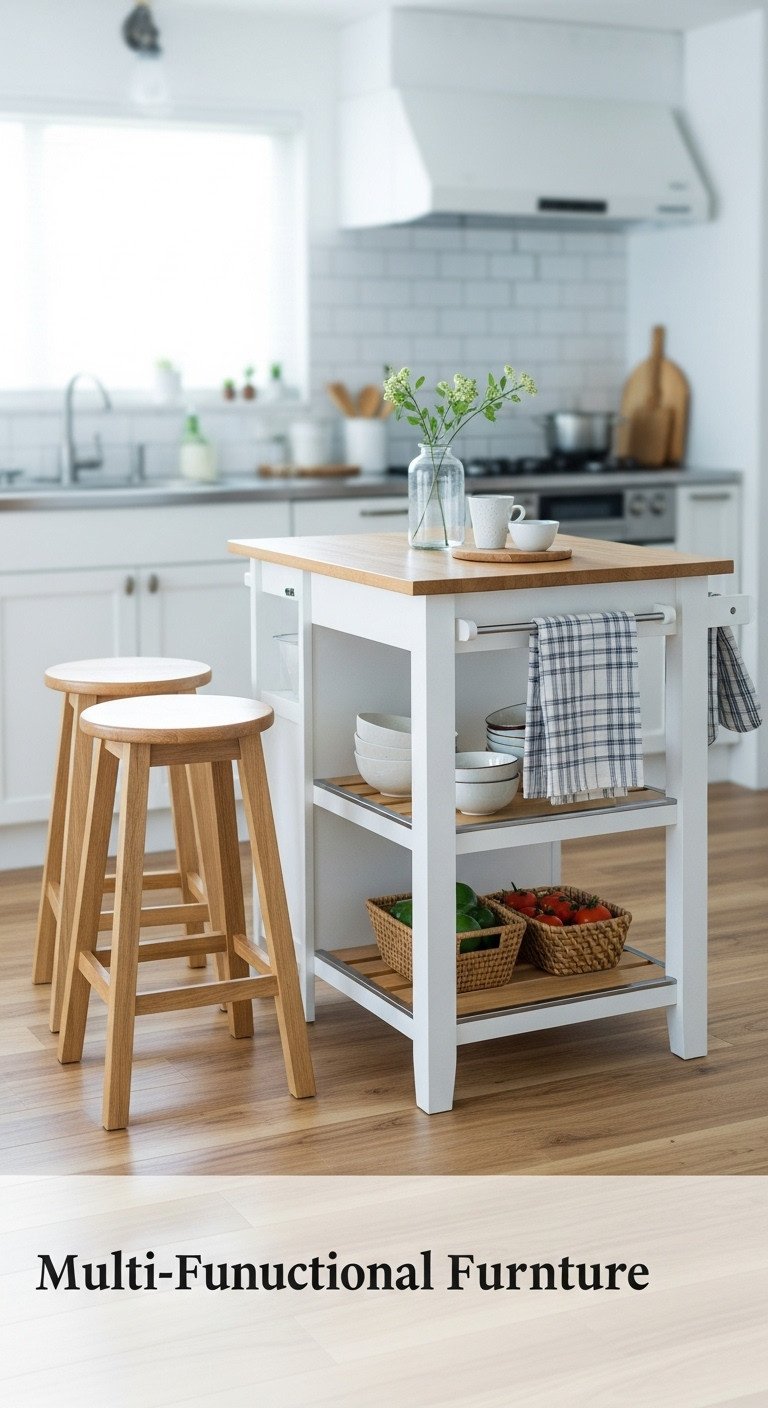
In a compact space, every piece of furniture should serve at least two purposes. A small rolling kitchen cart is a perfect example of smart, multi-functional design, providing extra prep space, storage, and even a dining spot without permanently occupying floor space.
- Materials Needed: A compact kitchen island or cart.
- Step-by-Step Directions:
- In a small kitchen, every piece of furniture should serve at least two purposes.
- A small rolling kitchen island cart with a wood top is the perfect addition. It provides extra countertop space for food prep.
- The shelves or cabinets below can be used for storing pots, pans, or small appliances, freeing up cabinet space.
- It can also double as a small breakfast bar or a serving station when you have guests.
- Look for one with wheels so you can easily move it out of the way when you need more floor space.
Lesson Learned: Measure your space carefully before buying an island cart. You need at least 3 feet of clearance around it for comfortable movement. A cart that is too large will make the kitchen feel more cramped, defeating the purpose.
Save this smart space-saving furniture idea!
7. Add Subtle Texture with a Stone Backsplash
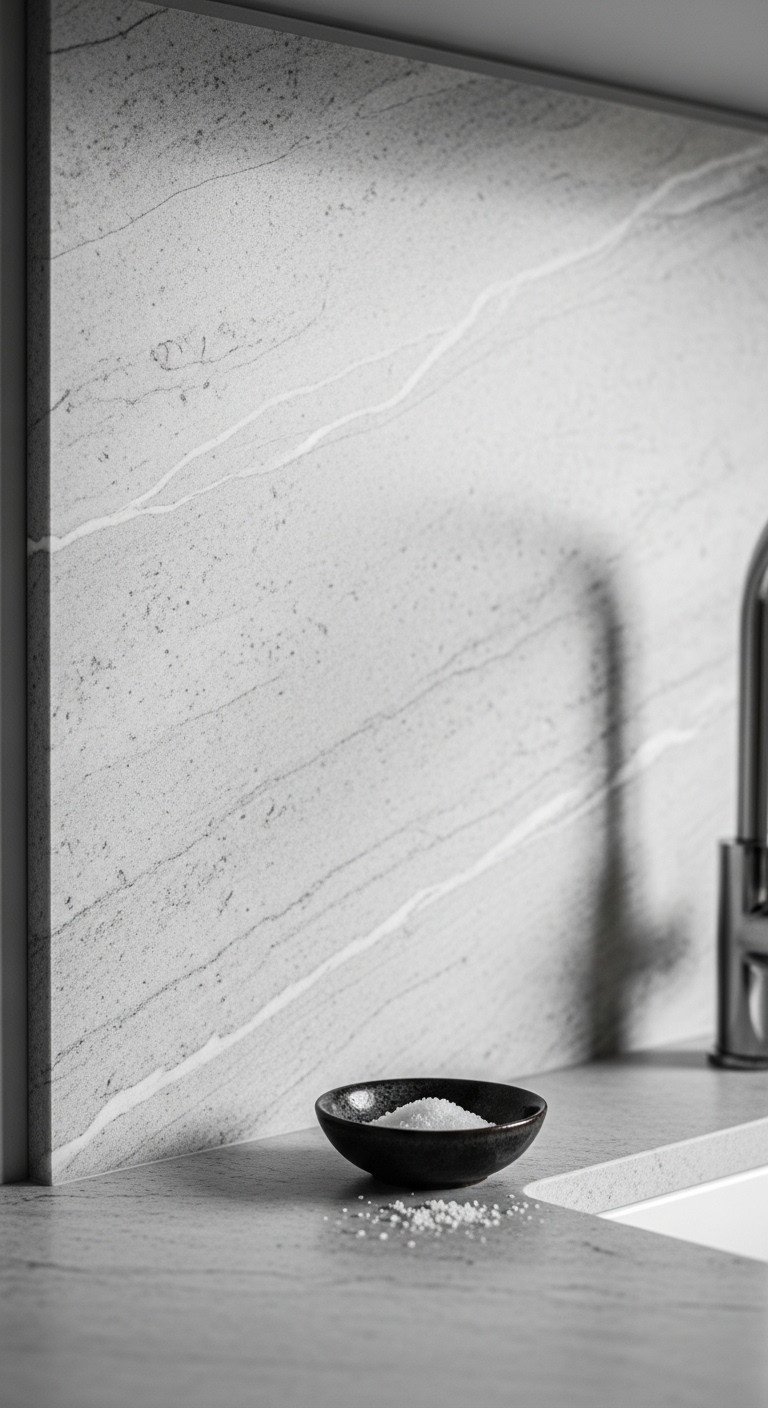
To keep a neutral palette from feeling flat, introduce subtle texture with a stone backsplash. A honed or matte finish stone with quiet veining adds a layer of organic sophistication and interest without overwhelming the small space with a busy pattern.
- Materials Needed: Peel-and-stick stone tiles, utility knife, level, measuring tape.
- Step-by-Step Directions:
- Choose a stone with quiet, subtle patterns. Loud, busy veining can make a small kitchen feel chaotic. A honed or matte finish is more in line with the Japanese aesthetic than a high-gloss polish.
- For a budget-friendly and renter-friendly option, consider a high-quality peel and stick stone backsplash. Modern versions look incredibly realistic and are easy to install.
- Thoroughly clean and dry your existing wall or backsplash before starting.
- Measure your space and plan the layout of the tiles. Use a level to draw a guideline for the first row.
- Carefully peel the backing and press each tile firmly into place, cutting tiles with a utility knife as needed to fit around outlets and corners.
Pro-Tip: When using peel-and-stick tiles, slightly overlapping them (if the manufacturer recommends) can create a more seamless and professional-looking grout line.
Pin this elegant stone backsplash for a touch of luxury!
8. Select Sleek, Compact Appliances
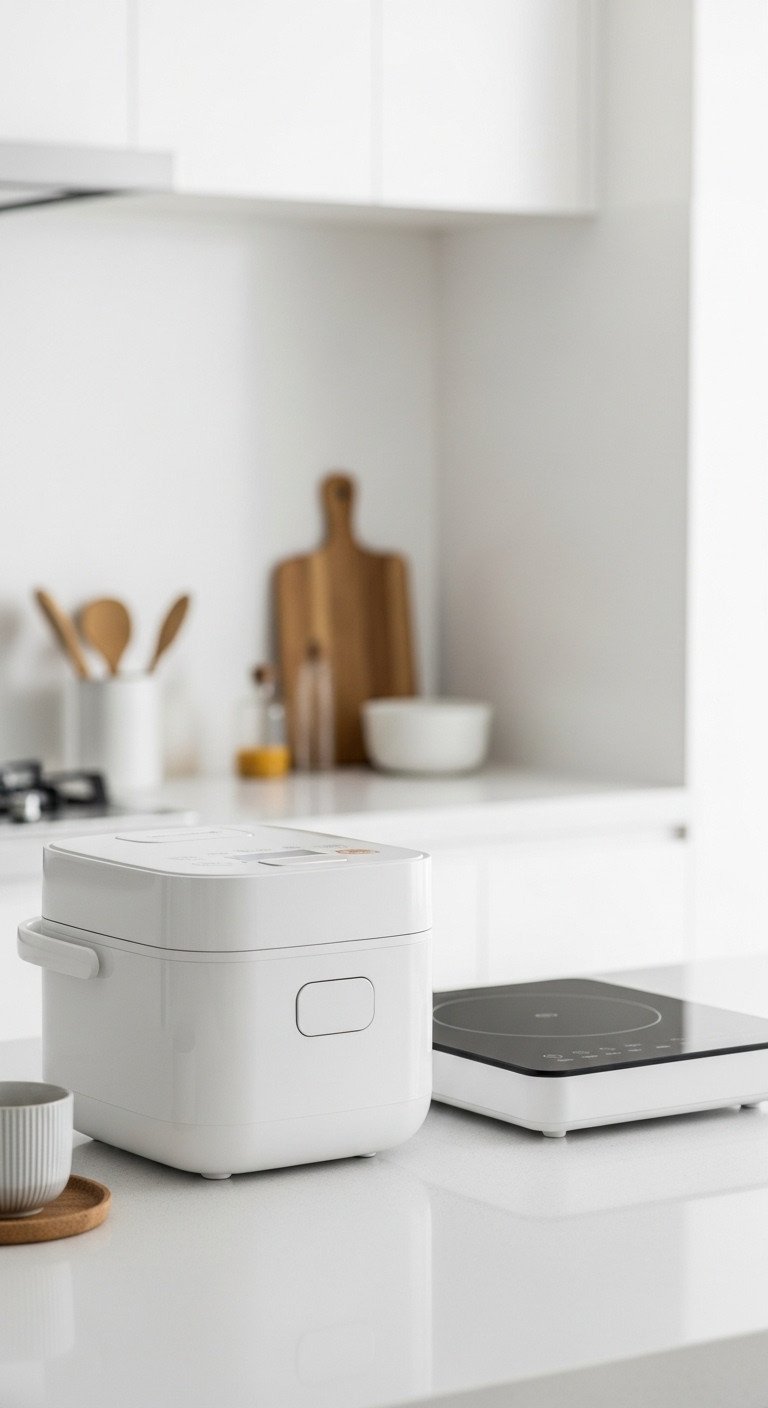
Bulky appliances are the biggest space-hogs in a small kitchen, so choose sleek, compact appliances that fit your actual needs. Apartment-sized models and portable cooktops free up valuable counter and floor space while maintaining full functionality.
- Materials Needed: Compact appliances suited to your cooking style.
- Step-by-Step Directions:
- Resist the urge to buy oversized American-style appliances. Opt for “apartment-sized” or compact models.
- If you don’t cook for a large family, consider a two-burner cooktop instead of four. A portable single burner induction cooktop is a fantastic option as it can be stored away when not in use, freeing up counter space.
- Choose appliances with clean lines and minimal branding. Integrated appliances that can be hidden behind cabinet panels are the ultimate minimalist choice.
- Prioritize the appliances you use most. If you make rice daily, invest in a high-quality, beautiful rice cooker that you’re happy to see on your counter.
Lesson Learned: Think about how you actually cook. Many people buy a full-size oven and rarely use it. A smaller convection microwave or a high-end toaster oven might be a more space-efficient and practical choice.
Save this to your ‘Tiny Home’ board for appliance inspiration!
9. Welcome Nature with a Touch of Greenery
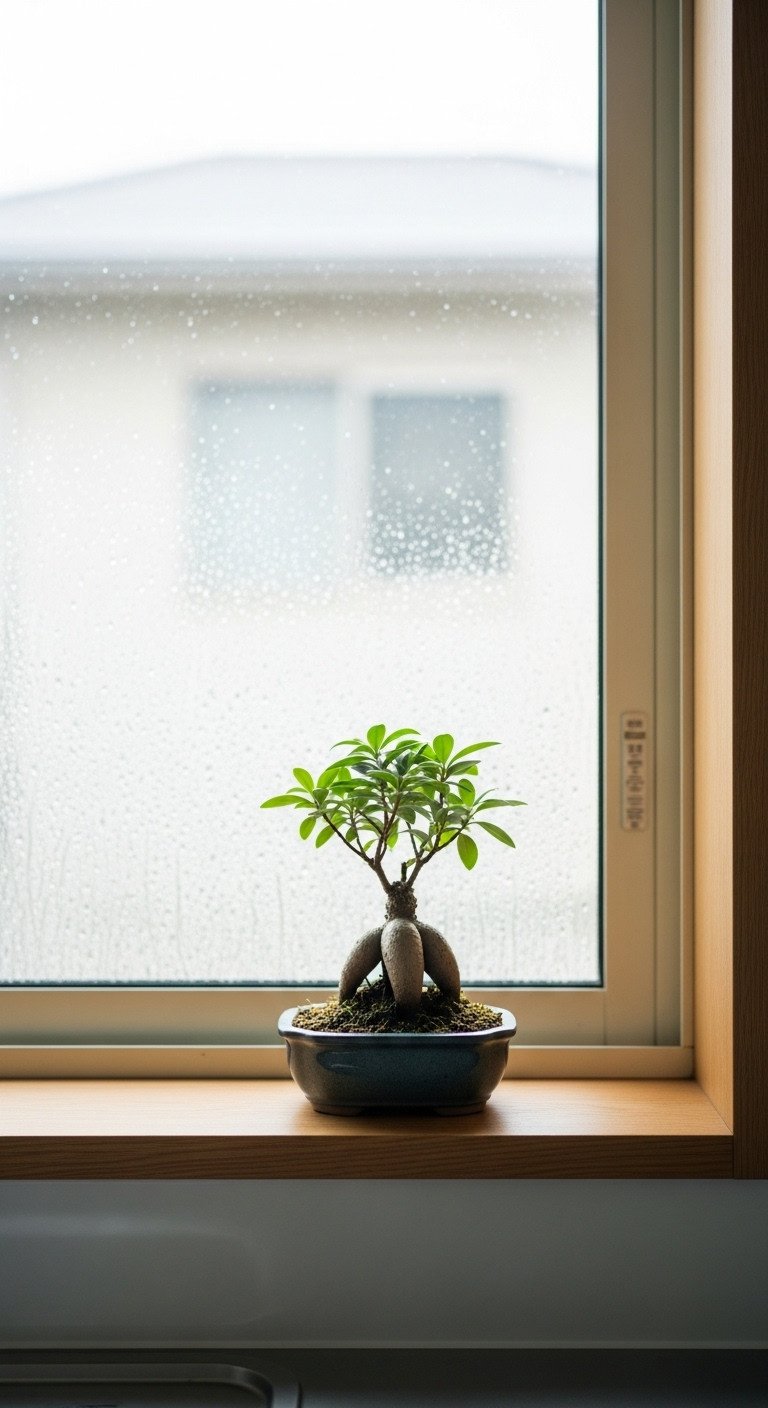
A connection to nature is vital in Japanese design, so bring life and tranquility into your kitchen with a single, well-chosen plant. This small touch of green purifies the air and adds a sculptural, organic element that breaks up the hard lines of a kitchen.
- Materials Needed: A small plant, a simple ceramic pot.
- Step-by-Step Directions:
- In Japanese design, a connection to nature is essential. A small plant can bring life and tranquility to your kitchen.
- Choose a single, sculptural plant rather than a collection of many small ones. A small bonsai, an orchid, or a snake plant works well.
- The container is as important as the plant. Select a minimalist small ceramic planter in a neutral color like white, black, or beige, preferably with a drainage hole.
- Place your plant on a windowsill, a floating shelf, or in a corner of the counter where it won’t be in the way but can still be appreciated.
- A small vase with a single stem or branch (Ikebana) is another beautiful, minimalist option.
Pro-Tip: If you’re new to plants, start with something low-maintenance like a snake plant or a ZZ plant. They thrive on neglect and can tolerate the lower light conditions often found in kitchens.
Bring your kitchen to life! Pin this green decor idea.
10. Create an Illusion of Space with Sliding Panels
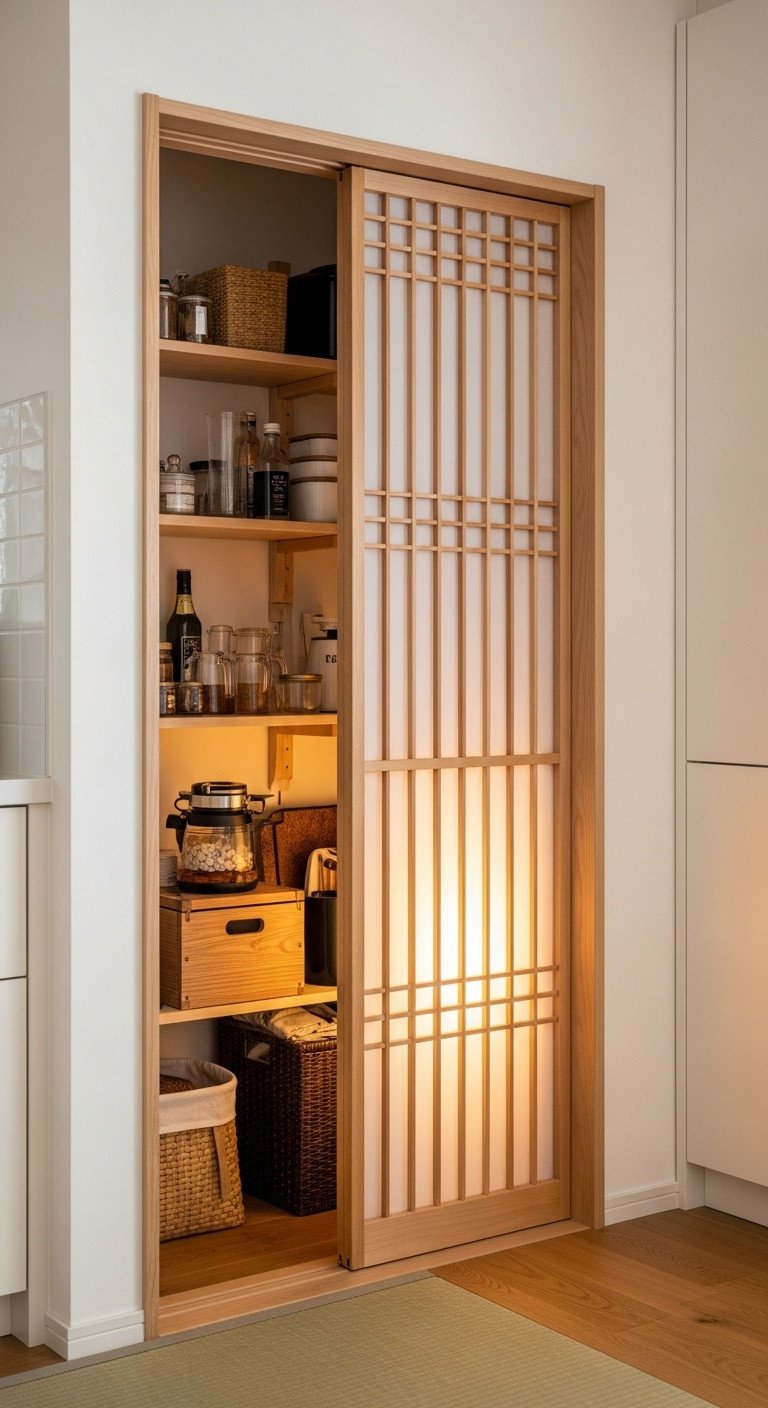
To conceal clutter without sacrificing floor space, use sliding panels or blinds instead of traditional swinging doors. This classic Japanese technique is perfect for hiding a pantry or open shelving, maintaining a clean look without the awkward door swing that cramps a small room.
- Materials Needed: A bamboo roll-up blind, cup hooks, measuring tape.
- Step-by-Step Directions:
- Traditional swinging doors eat up valuable floor space. Sliding panels are a core element of Japanese design that saves space.
- While installing a full Shoji screen might be a large project, you can get a similar effect easily.
- Identify an open pantry or a set of shelves you’d like to conceal.
- Install a bamboo roll-up window blind in front of the opening. It provides the same visual texture and conceals the clutter, but is incredibly easy to install.
- Simply install two or three hooks above the opening and hang the blind. You can roll it up for access and roll it down to hide everything.
Lesson Learned: Ensure the blind is slightly wider than the opening you are trying to cover to prevent seeing the clutter from the sides. Measure twice, buy once!
Pin this clever idea to hide kitchen clutter!
11. Perfect the Look with “Japandi” Fusion Accessories
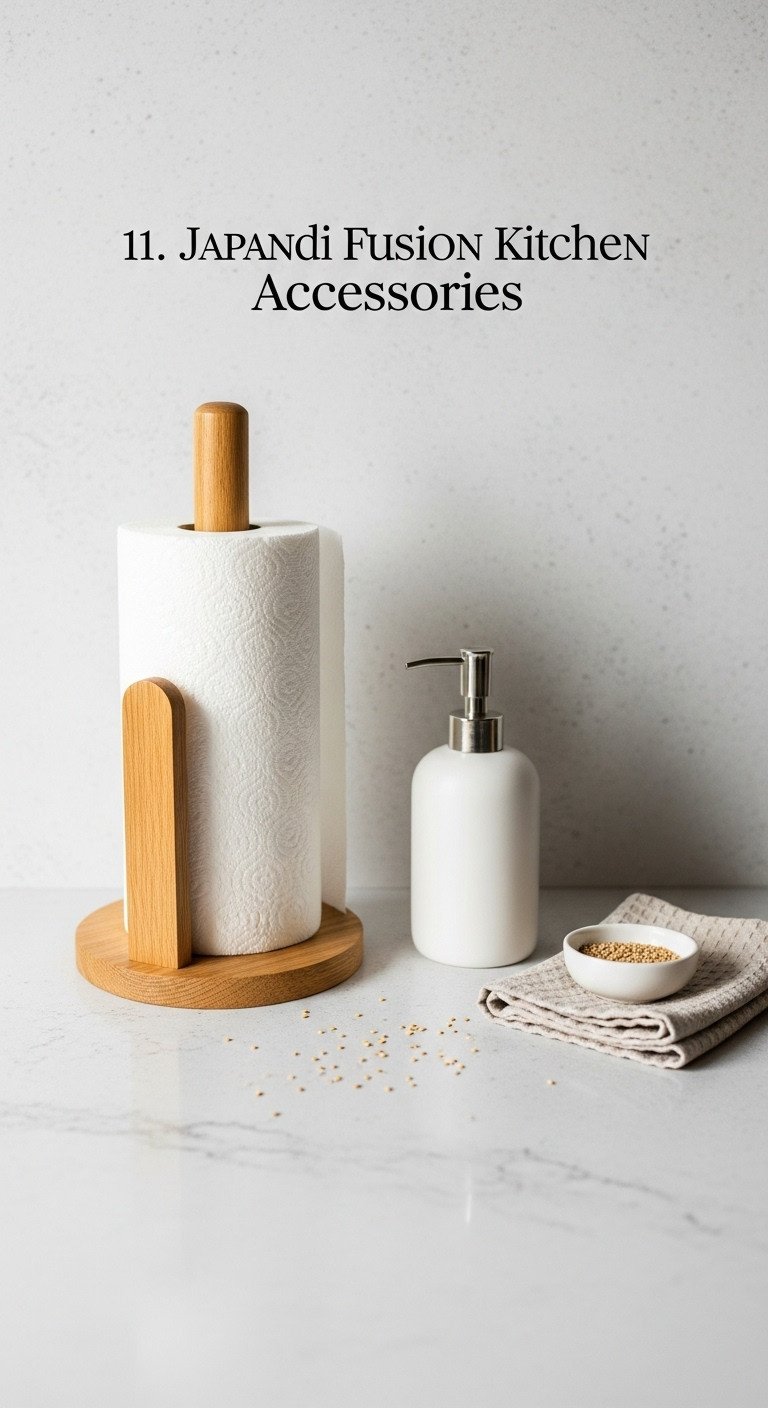
The final touch is to elevate everyday items with Japandi-style accessories. This fusion of Japanese minimalism and Scandinavian warmth focuses on making functional items beautiful, using natural materials like light wood, ceramic, and linen to create a cohesive and cozy feel.
- Materials Needed: Coordinated kitchen accessories in natural materials.
- Step-by-Step Directions:
- Japandi style blends Japanese minimalism with Scandinavian warmth—a perfect match for a cozy, functional kitchen.
- Focus on everyday items. Instead of a plastic paper towel holder, upgrade to a simple light oak wood paper towel holder for the countertop.
- Decant your hand soap and dish soap into simple, matching ceramic or glass dispensers.
- Replace old, brightly colored dish towels with a set of high-quality linen or cotton towels in muted, earthy tones.
- The key is to elevate the functional items you use every day into beautiful, cohesive design elements.
Pro-Tip: Create a “kitchen essentials” tray. Place your soap dispenser, a dish brush, and a small plant on a small wooden or stone tray next to the sink. It corrals clutter and makes the whole area look more intentional and tidy.
Get the Japandi look! Pin these simple accessory ideas!
Key Takeaways: Your Quick Guide to a Small Japanese Kitchen
- Less is More: The foundation of a Japanese kitchen is minimalism. Declutter ruthlessly and ensure every item has a purpose and a place.
- Embrace Nature: Incorporate natural materials like wood, bamboo, and stone to add warmth and texture, creating a connection to the outdoors.
- Function First: Prioritize a smart, ergonomic layout and multi-functional elements. Good design makes cooking and cleaning smoother and more enjoyable.
- Light and Bright: Use a muted, light color palette and layered lighting to make the space feel larger, brighter, and more serene.
@juicedkitchens Kitchen design across countries and cultures is interesting. Why do you think the kind of aspirational kitchen / editorial content differs between Japan and the US? Which do you prefer? #sustainabledesign #kitchenremodel #kitchentok #kitchendesign #greenscreen
People Also Ask About Small Japanese Kitchens
What is a Japanese kitchen called?
A Japanese kitchen is called a “Daidokoro” (台所). Historically, it was also referred to as “kamado” (かまど), which means stove, as the stove was considered the symbolic heart of the home. Today, “Daidokoro” is the common term for the place where food is prepared in a Japanese house.
What is the 3×4 kitchen rule?
While not a specifically Japanese rule, the “3×4 kitchen rule” is a general interior design guideline suggesting a minimum clearance of 3 to 4 feet (about 1 meter) for walkways in a kitchen. This ensures there is enough space for comfortable movement, opening cabinet and appliance doors, and for more than one person to work without feeling cramped.
What is a very small kitchen called?
A very small kitchen is often called a “kitchenette.” Other common terms include a “galley kitchen” if it’s long and narrow, or a “micro-kitchen” when it’s extremely compact, often found in studio apartments or tiny homes. These designs prioritize space-saving appliances and clever storage solutions.
What is the average cost of a small kitchen remodel?
The cost varies widely by location and material quality. A budget-friendly, DIY refresh of a small kitchen could be under £1,000. A mid-range remodel with new cabinets and countertops typically costs between £10,000 – £25,000, while a high-end custom kitchen can exceed £25,000.
Final Thoughts
Transforming your small kitchen into a serene Japanese-inspired space isn’t about expensive renovations; it’s about a shift in mindset. By embracing minimalism, functionality, and natural beauty, you can create a kitchen that is not only a joy to cook in but also a peaceful retreat from the clutter of daily life.
What’s the first idea you’re excited to try in your own kitchen? Let us know in the comments below
Last update on 2025-10-15 at 12:24 / Affiliate links / Images from Amazon Product Advertising API
